“I’ll meet you at Pilot” my future wife said to me before hanging up the phone.
She was explaining to me how to get to her parents’ house. (This was before our phones were a GPS device.)
But by meeting me at the Pilot gas station, I knew exactly where that was.
In the town she grew up in, it was a local landmark. Right off the highway, Pilot always had the cheapest gas and was a spot everyone knew of.
That was over 10 years ago, though.
Now it’s just another gas station along the Interstate 40/Interstate 85 corridor in the middle of North Carolina.
However, even though it is just one of many gas stations with competitive gas prices across the country, legendary investor Warren Buffett felt the value was now ripe for an investment.
Last Tuesday, he announced his company, Berkshire Hathaway, would buy a 38.6% stake in Pilot Flying J, which operates the little truck stop I was meeting my future wife at.
To me, he is clearly going against one of his investing rules — never buy a stock you are not comfortable owning for 10 years.
And if you typically follow Buffett’s investments, this is one you should pass on. Here’s why.
The Oracle of Omaha
I have a lot of respect for the Oracle of Omaha. Who wouldn’t? He is the world’s third-richest person, and his success story is one of the greatest.
Many investors idolize him and simply buy whatever he buys.
However, I think he is making a mistake on his latest acquisition, Pilot Flying J.
It actually goes against one of his main rules, if you ask me.
I have used his No. 1 rule before, which is to never lose money, but he has a few other rules to invest by. One of them is to never buy something you don’t want to own for 10 years.
That’s his investment time frame in a nutshell. “If you aren’t willing to own a stock for 10 years, don’t even think about owning it for 10 minutes.”
But Buffett’s latest acquisition is one I am uncertain about in just five years, and I question its existence 10 years from now.
Still, that hasn’t stopped investors from chasing his trade.
TravelCenters of America LLC (Nasdaq: TA) jumped 10% on the news, without even knowing the financial details of the transaction. That’s partly because the announcement of the Pilot acquisition mentioned Berkshire Hathaway’s capital and ability to expand, and TravelCenters may be one acquisition it is eying.
However, I doubt the usefulness of a truck stop/gas station in a future that is going electric and self-driving.
Going Electric
I find it extremely ironic that Buffett made this acquisition in the same month that Tesla planned to unveil its electric, self-driving semitruck. Granted, it is several years away from being operational, but the fact remains that in five years, almost all of the new cars being released will be electric, as indicated by the major automobile manufacturers.
I’m sure Buffett has thought about this, and still finds the real estate that Pilot owns to be a worthy acquisition. But to me, in just five years this is a company that will be searching to find its place in a world that is going electric and autonomous.
Does Pilot just become a place to stop on long trips and use the restroom? Somewhere to get junk food? Or will it be branded as a completely different use? I don’t know.
But I do know that when major manufactures like Ford, General Motors and BMW make the shift over the next few years to an almost entirely electric and automatic fleet, the amount of charging stations will multiply. And I may be five years off, but that brings up Buffett’s 10-year time frame, and I don’t know what a gas station will be like in 10 years.
I just know it won’t be your typical gas station anymore. Because instead of having to stop at a gas station before you get home, you’ll simply charge up at your house.
And instead of having to stop for gas after a 300-mile trip, you’ll simply pull into the hotel and charge up while you stay there.
So this is not an investment I would want to own for the next 10 years. And I think trading TravelCenters is a risky bet at the moment too.
If you buy it, you’re hoping Berkshire Hathaway has its sights set on that company. Because if it doesn’t, TravelCenters will likely fall back. But betting against it is too much of a risk because of the possible acquisition.
For now, this is simply not the investment to follow Buffett on. And I don’t say that often.
Regards,

Chad Shoop, CMT
Editor, Automatic Profits Alert
In this exciting NEW VIDEO, Wall Street legend and former multibillion hedge fund manager Paul Mampilly pulls back the curtain on the biggest investment opportunity in the market today. What insiders are calling “The Greatest Innovation in History,” this revolution will mint more millionaires and billions than any technology that came before it. Right now, the current market for this technology is just $235 billion, but given how fast this technology is moving experts predict it will soar to $19 trillion by 2020. But 8,000% growth is just the beginning—and now’s your chance to get in on the action. [CONTINUE TO VIDEO]
Source: Banyan Hill
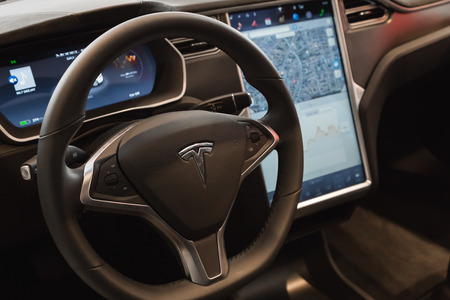

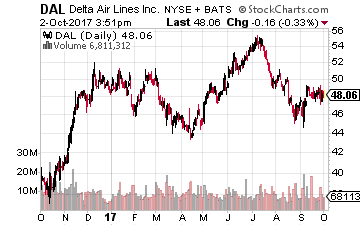 Delta operates a fleet of over 700 aircraft and serves more than 170 million customers annually. Its revenues fell 3% in 2016 to $39.64 billion, giving its efforts to reduce its debt levels more urgency. Its management is also maintaining capacity discipline while simultaneously trying to modernize its fleet and expand its operations.
Delta operates a fleet of over 700 aircraft and serves more than 170 million customers annually. Its revenues fell 3% in 2016 to $39.64 billion, giving its efforts to reduce its debt levels more urgency. Its management is also maintaining capacity discipline while simultaneously trying to modernize its fleet and expand its operations.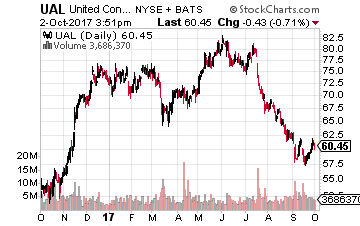 United is the world’s largest airline, operating about 5,000 flights a day. However, the merger of UAL with Continental has left the merged company with a significant debt load. Its significant exposure to Houston also means it was greatly affected by Hurricane Harvey.
United is the world’s largest airline, operating about 5,000 flights a day. However, the merger of UAL with Continental has left the merged company with a significant debt load. Its significant exposure to Houston also means it was greatly affected by Hurricane Harvey.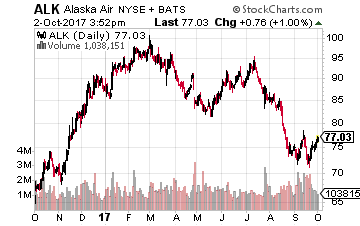 Alaska Air operations cover the western U.S., Canada and Mexico as well as, of course, Alaska. I like the purchase of Virgin America, despite the rise in the amount of debt it now has. The company’s August traffic report showed that its load factor (percentage of seats filled by passengers) increased to 86.2% from 85.8% in the year ago period as traffic growth exceeded capacity expansion.
Alaska Air operations cover the western U.S., Canada and Mexico as well as, of course, Alaska. I like the purchase of Virgin America, despite the rise in the amount of debt it now has. The company’s August traffic report showed that its load factor (percentage of seats filled by passengers) increased to 86.2% from 85.8% in the year ago period as traffic growth exceeded capacity expansion.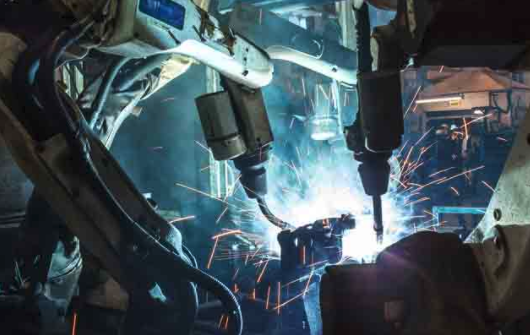



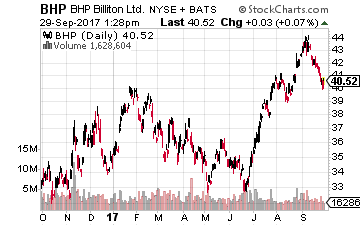 One company worth consideration to buy is the aforementioned diversified miner BHP Billiton (NYSE: BHP). It was the world’s fourth largest producer of copper in 2016 at 1,113 kilotons. A kiloton is equal to about 1,120 of our U.S. tons. BHP’s stock has risen 12% year-to-date and 17.6% over the last 12 months.
One company worth consideration to buy is the aforementioned diversified miner BHP Billiton (NYSE: BHP). It was the world’s fourth largest producer of copper in 2016 at 1,113 kilotons. A kiloton is equal to about 1,120 of our U.S. tons. BHP’s stock has risen 12% year-to-date and 17.6% over the last 12 months.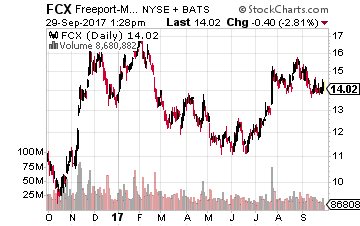 Next on the list is the world’s largest publicly-traded (Chile’s Codelco is government-owned) copper producer, Freeport-McMoran (NYSE: FCX), which trailed only Codelco in copper production last year (1,696 kilotons). Its stock is up 5.5% year-to-date and 27.5% over the past year.
Next on the list is the world’s largest publicly-traded (Chile’s Codelco is government-owned) copper producer, Freeport-McMoran (NYSE: FCX), which trailed only Codelco in copper production last year (1,696 kilotons). Its stock is up 5.5% year-to-date and 27.5% over the past year.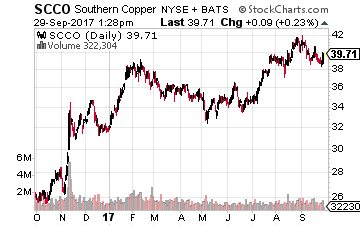 Another possibility is the fifth-biggest producer of copper in 2016, Southern Copper (NYSE: SCCO), which indirectly is part of Grupo Mexico and has operations in Peru and Mexico. Its stock rose 22% so far in 2017 and is up more than 46% over the past 52 weeks.
Another possibility is the fifth-biggest producer of copper in 2016, Southern Copper (NYSE: SCCO), which indirectly is part of Grupo Mexico and has operations in Peru and Mexico. Its stock rose 22% so far in 2017 and is up more than 46% over the past 52 weeks.
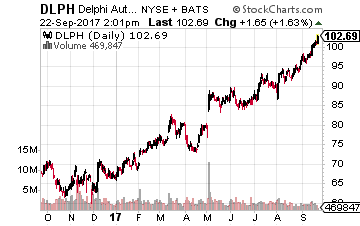 At the top of the list is a company that was once part of General Motors (NYSE: GM), Delphi Automotive PLC (NYSE: DLPH). The spinoff was completed in 1999, as sadly, GM management listened to Wall Street advice about streamlining operations by getting rid of a business “going nowhere.”
At the top of the list is a company that was once part of General Motors (NYSE: GM), Delphi Automotive PLC (NYSE: DLPH). The spinoff was completed in 1999, as sadly, GM management listened to Wall Street advice about streamlining operations by getting rid of a business “going nowhere.” 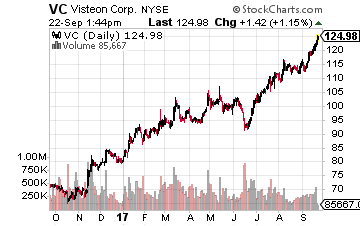 The next company to consider was also a spinoff – this time from Ford in 2000 – Visteon (NYSE: VC). The reasons were similar to those of General Motors.
The next company to consider was also a spinoff – this time from Ford in 2000 – Visteon (NYSE: VC). The reasons were similar to those of General Motors.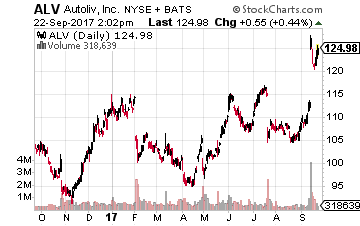 The third company has been a relative laggard, with its stock only up about 8.5% so far in 2017, the Swedish auto parts giant Autoliv (NYSE: ALV). Most of that upward movement in the stock price happened after a recent announcement.
The third company has been a relative laggard, with its stock only up about 8.5% so far in 2017, the Swedish auto parts giant Autoliv (NYSE: ALV). Most of that upward movement in the stock price happened after a recent announcement.
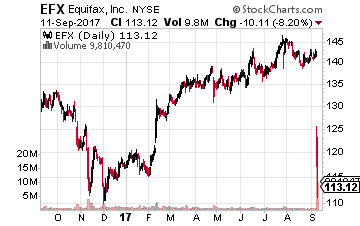 But first, more on this nasty underside of life in the 21stcentury coming to the fore again as the credit-reporting agency Equifax (NYSE: EFX) revealed a massive breach of its cyber defenses.
But first, more on this nasty underside of life in the 21stcentury coming to the fore again as the credit-reporting agency Equifax (NYSE: EFX) revealed a massive breach of its cyber defenses.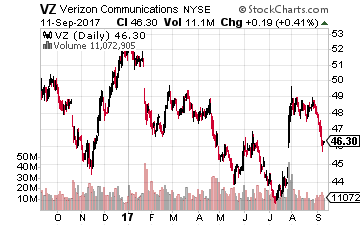 Of course, massive data breaches aren’t confined to just this industry. Last December, Yahoo (now part of Verizon (NYSE: VZ) revealed that attacks between 2013 and 2016 had compromised the personal information of more than a billion users. The data stolen included names, phone numbers, birth dates and passwords.
Of course, massive data breaches aren’t confined to just this industry. Last December, Yahoo (now part of Verizon (NYSE: VZ) revealed that attacks between 2013 and 2016 had compromised the personal information of more than a billion users. The data stolen included names, phone numbers, birth dates and passwords.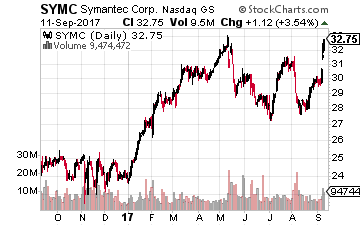 According to a report from cyber security company Symantec (Nasdaq: SYMC), hackers have breached the operational systems of utility companies in the U.S. Symantec says they are lying in wait with the ability to switch off the power and sabotage computer networks.
According to a report from cyber security company Symantec (Nasdaq: SYMC), hackers have breached the operational systems of utility companies in the U.S. Symantec says they are lying in wait with the ability to switch off the power and sabotage computer networks.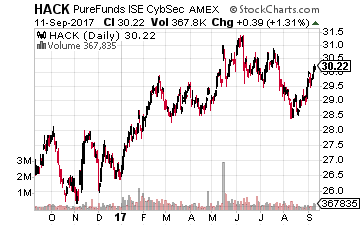 For the broadest possible exposure to the sector, I like the ETFMG Prime Cyber Security ETF (NYSE: HACK). It is up nearly 13% year-to-date and just 10% over the 52 weeks.
For the broadest possible exposure to the sector, I like the ETFMG Prime Cyber Security ETF (NYSE: HACK). It is up nearly 13% year-to-date and just 10% over the 52 weeks.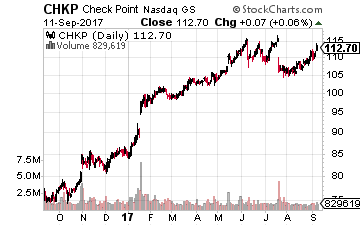 Palo Alto Networks offers network security solutions, such as next-generation firewall products, to businesses, service providers and governments. As of the end of 2016, the company was third in the security appliance segment (in terms of revenues) trailing only Cisco Systems and Check Point Software Technologies (Nasdaq: CHKP).
Palo Alto Networks offers network security solutions, such as next-generation firewall products, to businesses, service providers and governments. As of the end of 2016, the company was third in the security appliance segment (in terms of revenues) trailing only Cisco Systems and Check Point Software Technologies (Nasdaq: CHKP).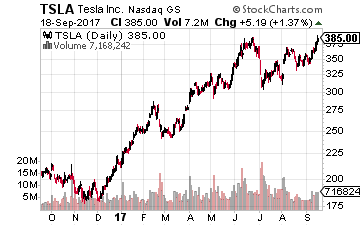 So let’s ‘imagine’ a bit… I’m going to reveal to you the best ways to play this milestone for the electric vehicle industry. And it does not involve buying Elon Musk’s Tesla Motors (Nasdaq: TSLA).
So let’s ‘imagine’ a bit… I’m going to reveal to you the best ways to play this milestone for the electric vehicle industry. And it does not involve buying Elon Musk’s Tesla Motors (Nasdaq: TSLA).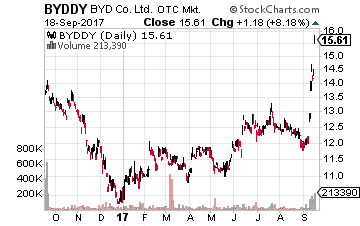 Leading the race already in China is BYD (OTC: BYDDY), of which Warren Buffet owns 8.25%. It is currently the world’s largest electric car maker and produced nearly 47,000 electric and hybrid vehicles in the first seven months of 2017.
Leading the race already in China is BYD (OTC: BYDDY), of which Warren Buffet owns 8.25%. It is currently the world’s largest electric car maker and produced nearly 47,000 electric and hybrid vehicles in the first seven months of 2017.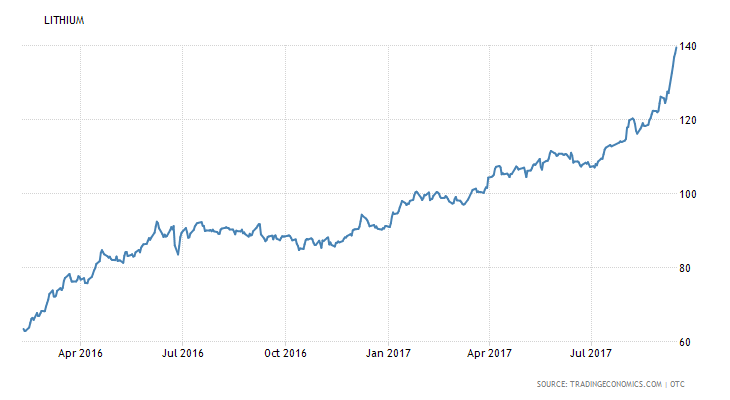 That hottest of all commodities sector centers on the key elements needed in lithium-ion batteries – lithium and cobalt (needed for the cathodes). These commodities account for roughly 60% of the cost of a lithium-ion battery, so says Simon Moores of the specialized consultancy, Benchmark Mineral Intelligence.
That hottest of all commodities sector centers on the key elements needed in lithium-ion batteries – lithium and cobalt (needed for the cathodes). These commodities account for roughly 60% of the cost of a lithium-ion battery, so says Simon Moores of the specialized consultancy, Benchmark Mineral Intelligence.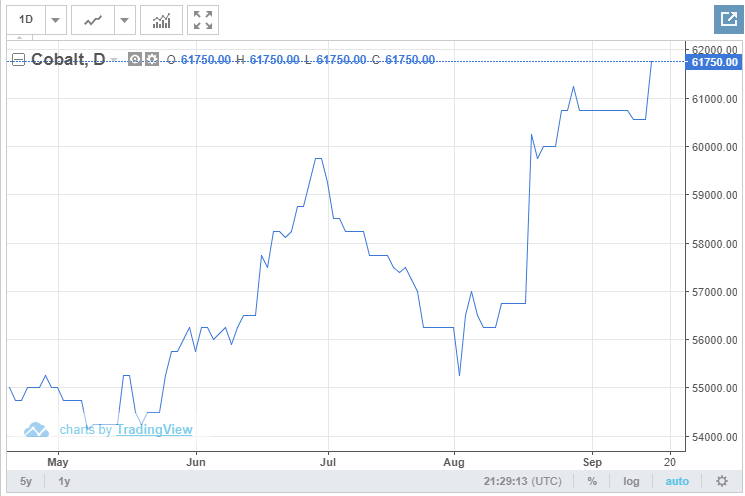 Investors almost got it right this past week when they poured money into the Global X Lithium & Battery Tech ETF (NYSE: LIT). Investors sent the price of this ETF up by 10.25% last week, pushing this year’s gain to 55.25%.
Investors almost got it right this past week when they poured money into the Global X Lithium & Battery Tech ETF (NYSE: LIT). Investors sent the price of this ETF up by 10.25% last week, pushing this year’s gain to 55.25%.